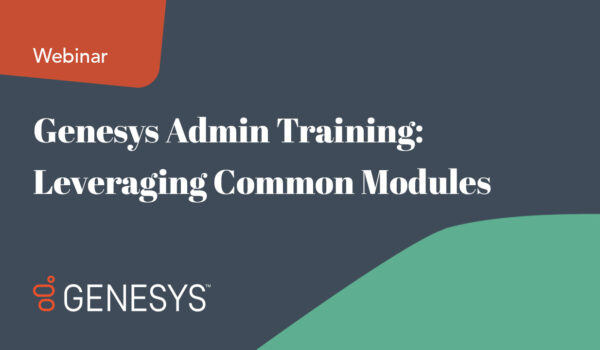
For part two of our Art of Reporting series (see our first post here), we’ll go over some metrics that occur just before the caller reaches a contact center agent: call abandonment rate, average speed of answer, and average queue time.
Call Abandonment Rate
Industry Guideline: 5%-8%
This KPI – in my opinion – is an absolute metric to track. Simply put, this metric tells us how many callers hung up before an agent was able to answer their call.
This metric points to: caller patience, caller frustration, possible staffing issues, and possible call routing issues. This metric impacts customer satisfaction and likely customer retention. Having an abandonment rate that is too high points to one issue, and likewise, having an abandonment rate that is too low points to a completely different issue. A healthy balance here is the goal.
Another often overlooked thought is that Call Abandonment Rates are often self-perpetuating and feeds upon itself.
Let me offer this example:
A caller reaches your contact center, becomes frustrated due to long wait times, and then hangs up. It is very likely that the caller will call the contact center back again and repeatedly in an effort that maybe “I will get through this time” and this inflates the Abandonment Rate and becomes an exaggerated issue. That is not to say that this overstates the Abandonment Rate. I would never diminish the abandonment rate by attempting to dilute the number by discounting repeat callers – which I have seen customers do – but it generally leads to more abandoned calls from frustrated repeat callers.
Add to that, when this caller does get through to the contact center agent, it is very likely that the customer will want to spend up to 30 seconds or more venting about his/her dissatisfaction and/or frustration in having to call back and/or having to wait an extraordinary amount of time to have the call answered.
Lastly – and this is an important and often forgotten aspect of the impact of abandoned calls – contact center agents that continually answer calls from disappointed and frustrated callers will more than likely have low agent morale.
Agent morale is a key concern in any contact center and should not be taken lightly. Anything you can do to improve the contact center customer experience and the contact center agent experience will pay dividends in your contact center operation. After all, your agents are your internal customers and care should be taken to manage their experience as well.
From the business perspective, the Abandonment Rate can have an impact on the profitability of the contact center in costly areas. There are other metrics that could be attributed to an excessive Abandonment Rate, and should be considered:
- Client attrition
- Lost sales
- Cost per call
- Unnecessary increased handle time
- Agent turnover
- Training costs for new agent
- Telco expenses
The Abandonment Rate has an impact across a wide spectrum of issues and should be considered closely.
Average Speed of Answer
Industry Guideline: 28 seconds
This is the average time it takes a call to be answered by a contact center agent. This includes the time waiting in queue, along with the time spent ringing to an agent. Closely related to the Service Level, it can also point to an often overlooked facet of the contact center: Agent Attentiveness and/or Agent Morale.
The ring time at a contact center agent desktop may highlight potential issues related to an agent’s ability to immediately answer an incoming call. There are reasons that a call may ring longer than normal at the agent phone that are not as black-and-white as they might seem.
Many contact centers have an internal 2-ring policy, while others may disregard this point by deploying an auto answer feature. The reasons for extended ring time might include the following thoughts:
- Previous wrap time: Does the agent type and talk at the same time?
- Work flow process: Are the desktop applications streamlined to ease the burden of agents having to “manage” applications instead of focusing on the customer? This is often an obstacle to agent performance and the agent usually is not responsible for 100% of this process. In my opinion, this is an often the most misunderstood obstacle in the contact center.
- Agent morale: Is the contact center agent ring time less at the start of the shift than towards the end of the shift? This could point to possible agent burnout and should be considered.
- Agent product knowledge: Is the agent sufficiently trained for the task at hand?
When I visit with clients, a really enjoy spending a fair amount of time watching agents take customer calls, but more importantly, I really focus on the agent application and the level of effort required of the agent to manage the customer inquiry with ease. My goal is always: find a way to simplify the contact center agent process, and in doing so, the contact center agent will find more time to focus on the customer. This is always a big win – for the customer and for the agent. This pays huge dividends for agent morale and customer satisfaction.
Average Queue Time
There is no industry-stated guideline, due to many factors, and it is an important metric to track. Queue time is inevitable and most callers expect some waiting time. However, there is a point where the Average Queue Time helps us better understand where we might be able to mitigate Abandonment Rates if monitored diligently. It also gives us a view into just how far off target any contact center might be from their stated Service Level goals, and there’s a direct correlation between Average Queue Time and customer satisfaction.
In reviewing Average Queue Time (AQT), it is important to look at the overall AQT along with the hour-by-hour view of this same metric. When isolated to the half-hour or hour, we can see at what point in the day we might be exceeding our expected service levels.
This may point out where we are falling short and may assist us in managing agent schedules and agent availability more appropriately.
At Inflow Communications, we are always looking for application nuances that dramatically impact operational efficiencies for the contact center. We look for creative ways to marry the operational needs with technology. Our goal is to help our clients achieve their goals with common sense and practical applications. Make sure to check back on the blog each Monday this month and learn more about these topics related to reporting.
And keep up with our on-going educational series in our blogs and keep tabs on our events, like our complimentary certified webinar trainings. Click here to find out when the next one is.
About Inflow
Founded in 1997, Inflow is one of the nation’s top Unified Communications and Contact Center consultants in today’s market. Pioneers in cloud unified communications and cloud contact center success, Inflow is the first company to provide contact center consulting and training focused solely on helping you elevate your customer experience.
With over 200,000 endpoints supported under Inflow’s innovative success programs around the world, Inflow built its brand and reputation around providing unrivaled customer support. Inflow is in Mitel/ShoreTel’s top 2% in global customer satisfaction, and quickly acquiring a top spot with RingCentral, Genesys PureCloud and NICE inContact.
By partnering with Inflow, you can expect the highest level of strategic consultation, execution, and optimization available in the industry.







